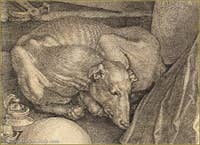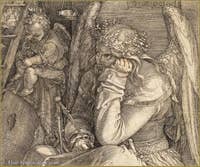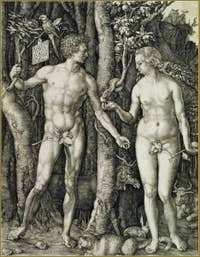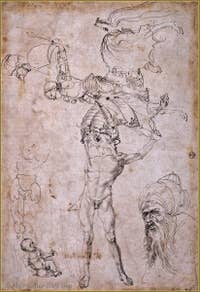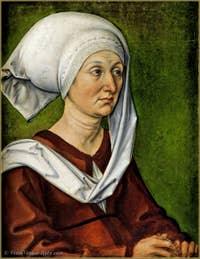Art Painters | Music | Literature | Video | Pictures
Painters Tintoretto | Titian | Canaletto | Fortuny | Albrecht Dürer |
Albrecht Dürer envied by the Venetian Painters
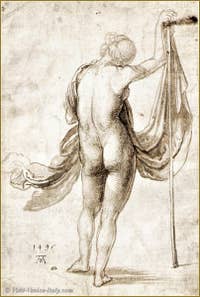
Nude woman 1495 Alas, his talents did not miss to provoke the jealousy of some Venetian colleagues who did not hesitate to use the good means of pressure to discourage and to get rid of this embarrassing rival…
That's how Dürer had to appear three times before the magistrates and to pay four Florins to the Scuola of Painters whose members, while criticising and by copying its works or appropriating its inventions, wanted to force him to pay taxes on Foreigners working in Venice.
In its correspondence with his friend Pirkheimer, Dürer confided its joy and fears:
“I would like you to be here in Venice, there are so many delightful companions […]
But we can also meet the most treacherous, the most untruthful and the most light-fingered louts who ever live in this lower world.”
Albrecht Dürer
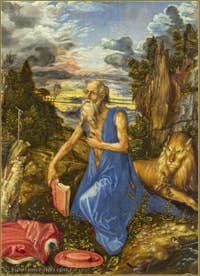
Saint Jerome His Venetian friends recommended him not to drink nor to eat with the painters. Obviously to avoid being poisoned!
Dürer Valued by Bellini
But the great Giovanni Bellini valued his talent at his fair value and did not miss to sing his praises to the Patricians.Bellini paid a visit to Dürer to ask him to do something to him, whom he would pay him.
With the money earned by the sale of "small" pictures accomplished in Venice, Dürer bought the ten books of Vitruve “architecture”, a partial version of which he will write in German.
He wrote his “Education on the way to measure” by drawing inspiration from Euclide “Optic Elements”.
And By Gabriele D'Annunzio
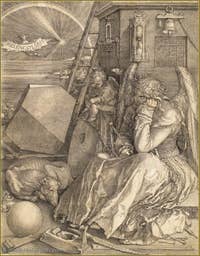
Albrecht Dürer - Melancholy
“Look, she says to her friend, by pointing to him out an engraving.
You know her well.
They knew her well one and the other; but they leant together to look at her, and she seemed to them new as music that always answers a different thing those who question it.
She was of the hand of Albert Dürer.
The big Angel of the Earth in eagle's wings, Mind without sleep, crowned with patience, was sitting down on the bare stone, the elbow on the knee, the cheek supported by the fist, having a book on the thigh and in the other hand the compass.
The dog was lying at her feet, picked up in a circle as a snake, the faithful greyhound, who the first, at the dawn of time, went hunting together with man.
Albrecht Dürer - Melancholy At her side, stuck as a bird on the edge of a millstone of mill, slept the already sad child, holding the pencil and the tablet where he had to write the first word of his science.
And around were scattered the tools of human works; and on the vigilant head, towards the top of a wing, cast into the hourglass the silent sand of Time; and one could see the Sea in the background with its gulfs, with its harbours, with its lighthouses, calm and indomitable, on which, while the Sun lay down in the glory of the rainbow, flied the concerning crepuscular bat with the revealing word written on her membranes.
Albrecht Dürer - Melancholy And these harbours and these lighthouses and these cities, it was him which had constructed them, Mind without sleep, crowned with patience.
He had cut the stone for the towers, cut down the pine for the ships, quenched the iron for all struggles.
And he had also imposed on Time the instrument which measures him.
Sat, not to have a rest, but to contemplate a new labour, he looked fixedly at Life, with his strong eyes where shone free soul brightly.
From all ambient forms, except one, silence went up.
Adam and Eve Only the fire voice could be heard, roaring in the stove, under the crucible where, from sublimated matter, had to procreate some new virtue to overcome a wrong or to know a law.
And the big Angel of the Earth with eagle's wings, who carried hanging to his side barded by steel the keys that open and that close, was answering to those who questioned him: The Sun goes down. The light that is born from the sky dies in the sky, and a day is unaware of the light of another day.
But the night is one, and its shadow stretches over all faces, its blindness on all eyelids, excepted on the face and on the eyelids of the one that holds its fire lighted to light its force.
Study I know that the living being is like the dead, the awaken as the sleeping, the young man as the old man, since the mutation of the one creates the other one; and any mutation has pain and joy for equal companions.
I know that the harmony of the World is made of dissension, as in the lyre and in the bow.
I know that I am and that I am not, and that there is only one and the same way, down and above.
I know the stench of rot and the infections without number that are inseparable from human nature.
However, notwithstanding my knowledge, I continue fulfilling my obvious or occult works.
Portrait of his mother I see some that perish, while I still last; I see others that seem intended to last, forever nice and unharmed of any misery, and which are not any more mine, though born in my deepest sorrows.
I see in front of the fire getting changed all things, as goods in front of the gold.
Only one is constant: my courage.
I sit down only to get up again.”
Gabriele d'Annunzio “The Fire”
In 1507, Albrecht Dürer comes back to Nuremberg
His break with Gothic art is accomplished: “The Apostles” recall Bellini, the “Self-Portrait in Gloves” draws inspiration from Giorgione and the splendid colours of the “Adoration of the Holy Trinity” show the beginning of the classical age of German painting.Previous Page
Painters Tintoretto | Titian | Canaletto | Fortuny | Albrecht Dürer |
Art Painters | Music | Literature | Video | Pictures
Back to Top of Page


